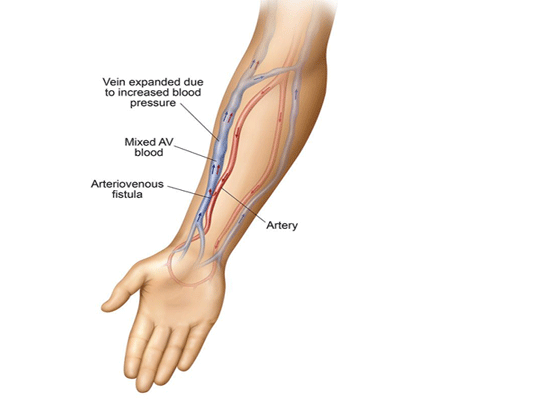When patients have chronic kidney disease or experience sudden kidney failure, there is a risk that their kidneys may permanently stop working. As a result, these patients will often receive haemodialysis several times a week. This is a treatment in which a machine is used to filter waste, eliminate excessive fluid and restore proper electrolyte balance in the blood. In order to more easily administer dialysis, a surgeon usually first has to connect an artery to a vein, creating an arteriovenous (AV) fistula.
If it is not possible to create a fistula, the surgeon will instead use an AV graft (a synthetic tube) to create the connection between the artery and vein. If an AV fistula or AV graft do not work properly and need to be re-opened or replaced, the condition is called an AV fistula (or AV graft) malfunction in renal insufficiency.

If you have an AV fistula or AV graft malfunction, your doctor may notice symptoms when clinically examining the fistula or graft, such as a throbbing sensation in the area or swelling of the arm caused by fluid retention.
Modern dialysis machines can identify some problems resulting from malfunctions, such as insufficient blood flow caused by a narrowing of the supplying artery (stenosis), or blood exerting abnormally high levels of pressure on vein walls as a result of the narrowing of a big vein in the chest.
A doctor can diagnose the condition using imaging techniques, such as colour Doppler contrast-enhanced CT, MRI or fluoroscopy.
AV fistula malfunctions usually occur when the narrowing in the veins has caused clots to form (thrombosis). Which treatment option is most suitable for you depends on the cause of the fistula malfunction and its location.
If the fistula malfunction was caused by narrowing in the vessels, an interventional radiologist can carry out a minimally invasive procedure called a percutaneous transluminal angioplasty. In this procedure, a catheter (a thin flexible tube) with a tiny balloon at the tip is inserted into the narrowed area under image guidance, and then the balloon is gently inflated to expand the area.
You may need to take medication to prevent the formation of blood clots, though this depends on your clinical situation.
